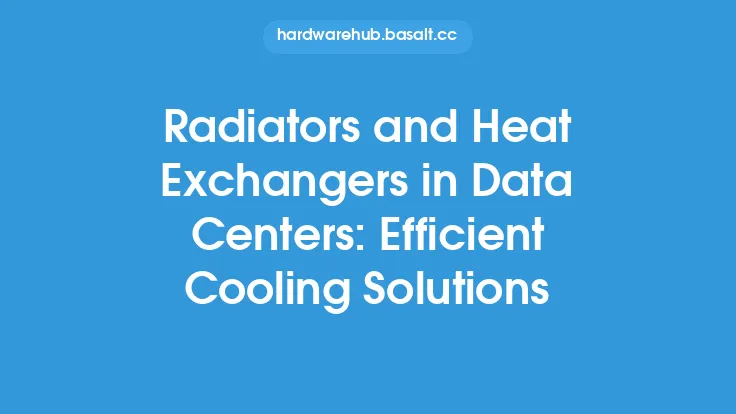The efficient operation of cooling systems is crucial in various industries, including automotive, aerospace, and power generation. At the heart of these systems are radiators and heat exchangers, which play a vital role in dissipating heat and maintaining optimal temperatures. In this article, we will delve into the world of radiators and heat exchangers, exploring their principles, designs, and applications, as well as their significance in achieving energy efficiency in cooling systems.
Introduction to Radiators and Heat Exchangers
Radiators and heat exchangers are devices designed to transfer heat from one fluid to another, often with the goal of cooling a system or component. They work by using a combination of conduction, convection, and radiation to facilitate heat transfer. Radiators, in particular, are designed to dissipate heat from a fluid, such as water or coolant, to the surrounding air. Heat exchangers, on the other hand, are used to transfer heat between two fluids, often with different temperatures and properties. The design and construction of radiators and heat exchangers can vary greatly, depending on the specific application and requirements.
Principles of Heat Transfer
To understand the operation of radiators and heat exchangers, it is essential to grasp the fundamental principles of heat transfer. There are three primary modes of heat transfer: conduction, convection, and radiation. Conduction occurs when heat is transferred through direct contact between particles or molecules. Convection, on the other hand, involves the transfer of heat through the movement of fluids. Radiation is the transfer of heat through electromagnetic waves. In radiators and heat exchangers, all three modes of heat transfer are often present, with convection being the dominant mechanism.
Design Considerations for Radiators and Heat Exchangers
The design of radiators and heat exchangers is critical to their performance and efficiency. Several factors must be considered, including the type of fluid, flow rates, temperature differences, and pressure drops. The material selection is also crucial, as it can affect the heat transfer coefficient, corrosion resistance, and durability. Additionally, the design must take into account the available space, weight constraints, and manufacturing costs. Computational fluid dynamics (CFD) and finite element analysis (FEA) are often used to simulate and optimize the design of radiators and heat exchangers.
Types of Radiators and Heat Exchangers
There are various types of radiators and heat exchangers, each with its own strengths and weaknesses. Radiators can be classified into two main categories: tube-and-fin and plate-type. Tube-and-fin radiators consist of a series of tubes with fins attached to increase the surface area, while plate-type radiators use a flat plate with a series of channels to facilitate heat transfer. Heat exchangers can be classified into several types, including shell-and-tube, plate-and-frame, and spiral-wound. Each type of heat exchanger has its own unique characteristics, such as compactness, pressure drop, and heat transfer coefficient.
Applications of Radiators and Heat Exchangers
Radiators and heat exchangers have a wide range of applications in various industries. In the automotive sector, radiators are used to cool engines, while heat exchangers are used in air conditioning systems and transmission coolers. In the aerospace industry, radiators and heat exchangers are used to cool aircraft engines, avionics, and electronic systems. In power generation, heat exchangers are used to cool steam turbines, gas turbines, and nuclear reactors. Additionally, radiators and heat exchangers are used in various industrial processes, such as chemical processing, oil refining, and food processing.
Energy Efficiency in Cooling Systems
The efficient operation of cooling systems is critical to reducing energy consumption and minimizing environmental impact. Radiators and heat exchangers play a vital role in achieving energy efficiency in cooling systems. By optimizing the design and performance of radiators and heat exchangers, it is possible to reduce the energy required to operate the cooling system. This can be achieved through the use of advanced materials, improved heat transfer coefficients, and optimized flow rates. Additionally, the use of intelligent controls and monitoring systems can help to optimize the operation of radiators and heat exchangers, reducing energy waste and improving overall system efficiency.
Maintenance and Repair of Radiators and Heat Exchangers
Regular maintenance and repair of radiators and heat exchangers are essential to ensuring their optimal performance and longevity. This includes cleaning and inspecting the heat transfer surfaces, checking for leaks and corrosion, and replacing worn or damaged components. Additionally, the use of condition-based maintenance and predictive analytics can help to identify potential issues before they become major problems, reducing downtime and improving overall system reliability.
Future Developments and Trends
The development of radiators and heat exchangers is an ongoing process, with researchers and manufacturers continually seeking to improve their performance, efficiency, and sustainability. Some of the current trends and future developments include the use of advanced materials, such as nanomaterials and composite materials, to enhance heat transfer coefficients and reduce weight. Additionally, the integration of radiators and heat exchangers with other system components, such as fans and pumps, is becoming increasingly popular, as it can help to improve overall system efficiency and reduce energy consumption. Furthermore, the use of additive manufacturing and 3D printing is enabling the creation of complex geometries and customized designs, which can help to optimize the performance of radiators and heat exchangers.





